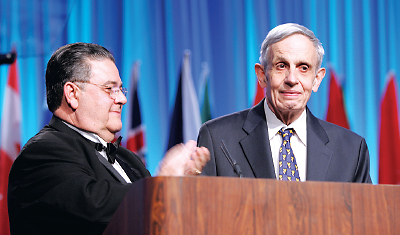John Nash, Subject of ‘A Beautiful Mind,’ Killed With His Wife in Car Crash
Abstract
“A Beautiful Mind” won four Academy Awards in 2001 for its portrayal of Nash’s brilliance, his struggle and partial recovery from psychosis, and the partnership he shared with his wife, Alicia.
John F. Nash Jr., Ph.D., the Nobel Laureate mathematician who had schizophrenia, was killed, along with his wife, in a car crash on May 23. He was 86.

Nobel Prize–winning mathematician John Nash, Ph.D., is pictured above with Pedro Ruiz, M.D., then APA President, in 2007. Nash delivered the William C. Menninger Convocation Memorial Lecture at APA’s 2007 annual meeting in San Diego.
Nash was the subject of the book and movie “A Beautiful Mind,” which told the story of his struggle with his illness.
The New York Times reported that Nash and his wife, Alicia, 82, were in a taxi on the New Jersey Turnpike when the driver lost control while veering from the left lane to the right and hit a guardrail and another car. The couple were ejected from the cab and pronounced dead at the scene.
The Nashes were returning home from the airport after a trip to Norway, where Nash and Louis Nirenberg, Ph.D., a mathematician from New York University, had received the Abel Prize from the Norwegian Academy of Science and Letters.
Nash shared the Nobel Prize for Economics in 1994 for his contributions to “game theory.” Nash’s theory of noncooperative games, published in 1950 and known as “Nash equilibrium,” offered a new way to analyze a range of competitive situations, and his brilliance had made him among the most highly regarded mathematicians of the 20th century.
Harold W. Kuhn, Ph.D., an emeritus professor of mathematics at Princeton and a friend and colleague who died in 2014, was quoted in the Times article as having once said, “I think honestly that there have been really not that many great ideas in the 20th century in economics, and maybe, among the top 10, his equilibrium would be among them.”
As Nash’s contributions to the field of mathematics gained prominence, however, he began to experience significant personal challenges. In 1959, Nash had the first of many hospitalizations after exhibiting signs of paranoid schizophrenia—an illness that eventually rendered him unable to work. His wife, family, and several colleagues stood by him throughout his illness, and by the early 1990s he recovered enough to resume some research and speaking.
In the early 1990s, some of those colleagues convinced the Nobel Prize committee that Nash was well enough to receive the prize, which he shared with two economists, John C. Harsanyi, Ph.D., of the University of California, Berkeley, and Reinhard Selten, Ph.D., of the Rheinische Friedrich-Wilhelms University in Bonn, Germany.
In 2001, the movie “A Beautiful Mind,” based on a 1998 biography of the same name by Sylvia Nasar, won four Academy Awards. The movie, which featured Russell Crowe as the mathematician, was widely popular—grossing more than $300 million worldwide—and did much to increase the awareness of schizophrenia among the general public.
Nash delivered the William C. Menninger Memorial Convocation Lecture at APA’s annual meeting in 2007, in San Diego, where he suggested that mental illness might be an adaptive consequence of the diversification of species.
William Carpenter, M.D., who was chair of the DSM-5 Work Group on Psychosis, recalled meeting Nash and his wife once for dinner, after Nash had spoken at a scientific program. Carpenter recalled Nash as shy and his wife as “outgoing,” and noted that Nash himself never claimed to be fully recovered from his illness.
“The death of John Nash and his wife is very sad, and a loss for psychiatry,” Carpenter told Psychiatric News. “Awareness of his profound intellectual accomplishments and his struggle with schizophrenia did much to increase public understanding and decrease stigma.” ■



